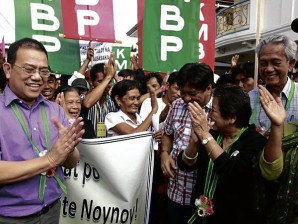DAR distributes 480 ha

THIS LAND IS YOURS Agrarian Reform Secretary Virgilio de los Reyes leads a group of government officials, including Agriculture Secretary Proceso Alcala, Human Rights Commissioner Etta Rosales and Antipoverty Chairman Joel Rocamora, during a distribution of certificates of land ownership to farmers in Mulanay, Quezon, on Wednesday. DELFIN T. MALLARI JR./INQUIRER SOUTHERN LUZON
MULANAY, Quezon—Despite a warrant for his arrest, Rodolfo Pagatpat, 60, a tenant at the vast Villa Reyes in nearby San Narciso town, on Wednesday joined an estimated 5,000 farmers from the Bondoc Peninsula at the distribution of certificates of land ownership award (CLOA) under the Comprehensive Agrarian Reform Program (CARP).
“I have to be here to witness the culmination of our long and painful struggle to own the land that we have been tilling for several generations,” Pagatpat told the Inquirer at a parking lot in this rustic town on the edge of Tayabas Bay.
According to Jansept Geronimo, campaign officer of the Quezon Association for Rural Development and Democratization, which has been helping the farmers, the Department of Agrarian Reform (DAR) distributed CLOAs for 480 hectares of the vast farmland owned by the scions of the late Don Domingo Reyes in the towns of San Narciso, Buenavista and San Andres.
“There will be another distribution of 120 hectares in March and another 524 hectares in June. There is no more legal impediment to its distribution,” Geronimo said.
Records of the Kilusang Magbubukid ng Bondoc Peninsula (KMBP) show that 303 criminal cases, mostly for the qualified theft of coconuts, have been filed against 223 tenants who complained of harassment by several landlords whose estates were under CARP coverage.
Article continues after this advertisementOne of the victims of harassment was Pagatpat, who said he has been living in the mountains since 2006 to avoid authorities. “Once I am arrested, I have to shell out close to P100,000 for my bail, which I don’t have. But I’m not in hiding. I’m just living far from my family,” he said.
Article continues after this advertisementAgrarian hot spot
Pagatpat said his son would receive the CLOA for him, which would entitle him to the legal ownership of three hectares of land. His niece Rosita, 56, a tenant of Villa Reyes for the past 40 years, also received her CLOA for more than one hectare of land.
In between sobs, she said she had spent time in jail for the “unjust charge of stealing coconuts which our forebears had planted.”
Mulanay is regarded as one of the “agrarian hot spots” in the Bondoc Peninsula because of landowner resistance and the land distribution ceremony was a symbolic gesture of the government’s sincerity in pushing ahead with the agrarian reform program expiring in 2014.
The farmers traveled from different towns and assembled at the town entrance since early morning. They later marched toward the town plaza for the distribution of the CLOAs by a government delegation led by Agrarian Reform Secretary Virgilio de los Reyes and included Agriculture Secretary Proceso Alcala, Commission of Human Rights Chairperson Etta Rosales and National Anti-Poverty Commission Chairman Joel Rocamora.
In a short dialogue under the scorching noonday sun, farmer Myrna Fontamillas of Barangay (village) Lakdayan, San Narciso, engaged the government officials in an argument on why the agrarian reform beneficiaries still had to pay for the land.
In the end, apparently convinced by the explanation of government representatives, the woman hugged and kissed Alcala in gratitude while the rest of the farmers and officials applauded.
End to Bondoc disputes
De los Reyes said the distribution was only the beginning. “The government will bring to an end the agrarian disputes in the Bondoc Peninsula,” he told newsmen.
He said the DAR was now speeding up land distribution under CARP, particularly those lands with “notice of coverage.” He said this would continue even after CARP ends. He said that nothing in the law stated that the DAR could not distribute CARP-covered lands beyond June 2014.
The DAR’s P21-billion budget for 2013 covers land acquisition and distribution; and includes more than P2.3 billion for support services, up from P800 million this year.
Joyous farmers
“The farmers are all joyous. Most of them shed tears when they were informed of this land distribution event,” said Maribel Luzara, KMBP president.
The agrarian reform initiative was initiated by President Aquino’s late mother, then President Corazon Aquino, on June 10, 1988, as the centerpiece of a social justice program to lift farmers from poverty and eliminate one of the causes of a lingering communist insurgency.
On Aug. 7, 2009, then President Gloria Macapagal-Arroyo signed into law Republic Act No. 9700, or the Carper (CARP extension with reforms) Law. This extended CARP for another five years with a total budget of P150 billion.